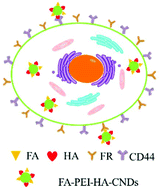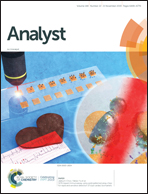Dual-ligand functionalized carbon nanodots as green fluorescent nanosensors for cellular dual receptor-mediated targeted imaging†
Abstract
The conjugation of ligands to nanoparticles as drug delivery systems that target specific cells is a promising approach for the delivery of therapeutic agents to tumor cells. Herein, we prepared green-emission fluorescent carbon nanodots (CNDs) by a facile hydrothermal method with D-(+)-glucosamine hydrochloride and L-aspartic acid as the precursors, then covalently conjugated with folate (FA), polyethyleneimine (PEI) and hyaluronic acid (HA) to develop dual ligand-decorated nanocarriers (FA-PEI-HA-CNDs) for the targeted imaging of cancer cells. FA-PEI-HA-CNDs integrated the excellent fluorescence property of CNDs, and can be used for the real-time and noninvasive location tracking of cancer cells. The cellular uptake study demonstrated that FA-PEI-HA-CNDs markedly improved the internalization efficiency in A-549 cells via folate/CD44 receptor-mediated endocytosis in comparison with that of the A549 cells pretreated with excess FA, HA, and FA and HA. Therefore, these dual folate/CD44 receptor-targeted CNDs (FA-PEI-HA-CNDs) show promising potential for cancer detection, drug delivery, and individualized treatment as performance platforms.



 Please wait while we load your content...
Please wait while we load your content...